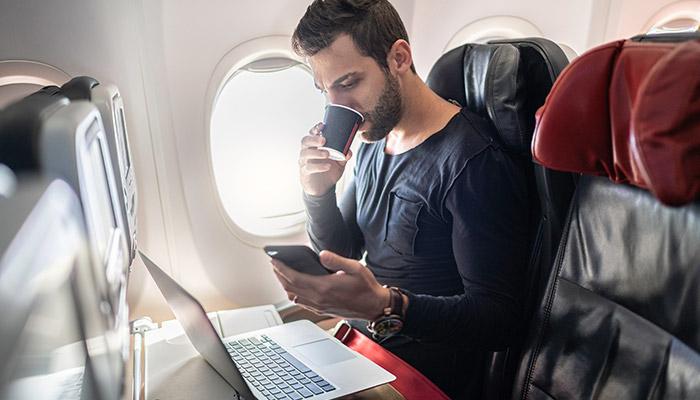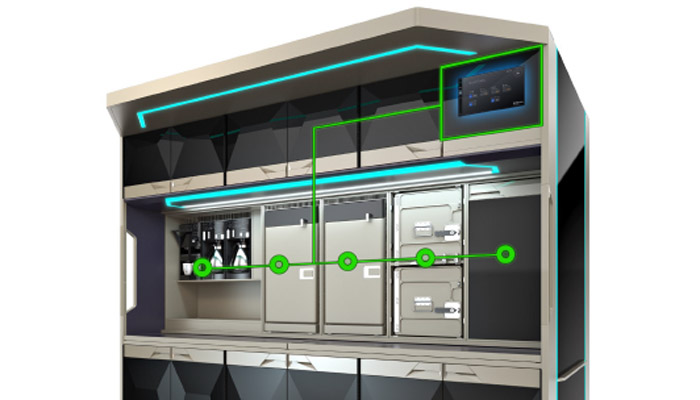Across the globe, we have come to expect to navigate, operate and micromanage the world at an increasingly granular level through our personal devices.
The issue is no longer one of airlines driving customers to use their device as part of an airline process; customers expect airlines to provide processes and services via their devices. In travel, overall delivery of personal device-based services is increasing and new ideas are making their way to the skies.
Increasing in-flight connectivity
It’s estimated that the number of aircraft installed with in-flight connectivity (IFC) is expected to double from 9,026 at the end of 2020 to approximately 18,500 in 2029, according to The Future of In-Flight Connectivity – 2020 Edition, issued in February by Valour Consultancy. However, this will only represent just over half of the global passenger fleet, which is projected to reach nearly 34,000 by 2031 according to management consultancy Oliver Wyman.

A vision to embed the cabin interior into a digital ecosystem that enables passengers to fine-tune their flight experience from their mobiles and crew to manage services more efficiently has already been set out. Implementation is being held back – the immediate hygiene requirements and financial challenges of the global health crisis have had a heavy impact. But the fact that passengers mobile devices are for the most part unconnected in flight is an issue still to be bridged.
Onboard entertainment through W-IFE
The first step for many airlines is likely to be wireless in-flight entertainment (W-IFE), which Valour’s report forecasts will be installed on almost three-quarters of the global narrow-body fleet by 2030, up from just over a third today.
However, as demands on the aircraft’s connected communications from passengers and crew increase, more sophisticated management will be required.
To address these needs Inmarsat and Boeing last summer unveiled ‘smart pipe’ infrastructure designed to independently allocate connectivity bandwidth to multiple applications onboard the new Boeing 777X. This means that applications delivered on Inmarsat’s GX Aviation and SwiftBroadband-Safety (SB-S) Satcom solutions are each able to have a unique service level agreement and guaranteed performance levels, independent of other applications that are operating through the same terminal.

For Philip Balaam, President of Inmarsat Aviation, this paves the way for a “more connected and integrated future, which is critical for airlines around the world that are transforming their business with the power of digital technology”. He adds: “This is a significant milestone in developing the truly connected aircraft.”
Smart cabin designs
Several leading OEMs began the groundwork on connected cabin technologies in 2019. It was a focus of Boeing’s ecoDemonstrator programme and among the components on the B777 flying testbed was Diehl Aviation’s eSmart Galley monument, which features new communications architecture. The crew interface can be customised to crew needs and support tasks, such as inventory and power management for increased efficiency.

Diehl’s overall smart cabin concept includes welcoming the passenger onboard using facial recognition, guiding them to their seat and reserved overhead bin space, plus the ability to book lavatory time slots, all via their mobile device.
Similarly, the Airbus Connected Experience platform is aimed at providing passengers with more options to control their experience via their personal devices, such as ordering food and beverages remotely, controlling the seat environment and inflight entertainment. For airlines, it offers the potential to harness aggregated usage trends for predictive maintenance analytics over the fleet, thereby improving cabin reliability, quality, sustainability and performance onboard.
A seamless experience
A first realisation step from Airbus is a standardised on-board hardware and software infrastructure known as Open Software Platform (OSP). This enables the integration of digital services from multiple vendors and will also support future data analytics.
Last autumn, charter airline Titan Airways became the first to deploy OSP with integrated Bluebox Aviation W-IFE on its two new A321 neoLRs. For Ingo Wuggetzer, Vice President – Cabin Marketing at Airbus, OSP’s key achievement is that it allows airlines to customise their onboard passengers experience without any hardware or certification impact and without affecting cabin design.

Wuggetzer also sees an opportunity for a seamless, end-to-end smartphone application that is a portal to flight information, health and hygiene elements on the ground and in the air, all geared to enabling the touchless journey. Airbus got the ball rolling in March with the launch of Tripset, a travel companion app that aggregates travel information to restore passenger trust in their end-to-end journey.
Replacing printed material
Inflight solutions that provide passengers with more flexible and touchless choices onboard and introduce more automation to support crew tasks have emerged over the past year.
For example, Panasonic Avionics’ Welcome Aboard collection includes a digital reader and companion app, which allows passengers to pre-plan their onboard entertainment and control their seat-back screen, plus ZeroTouch, a solution that remotely delivers data, be it software, media or content, to the aircraft.
Meanwhile, Thales InFlyt Experience is working on cabin automation to decrease congestion, facilitate aircraft disembarkation and manage passenger flow using synthetic data.
Perfecting passenger options
As passengers navigate an increasingly digital and touchless onboard experience, so providing services and choices that are relevant and geared to their needs becomes even more important. Sabine Taillardat, who heads SITA FOR AIRCRAFT’s Cabin Connectivity Services portfolio, notes: “The role of personalisation in the passenger experience is critical in a touchless environment.”
Taillardat adds that targeted content opens up opportunities to generate ancillary revenue. “By integrating IFC services with airlines’ passenger manifest and frequent flyer programmes, passengers can quickly connect to view personalised information for their aircraft and route – all through the safety of their own device. The digitally native flyers are demanding access to personalised content via streaming services such as Netflix and Spotify.”
The final few hurdles
Before the promise of personal device-based inflight services can be realised, Airbus has identified some key hurdles that the industry will need to tackle. These centre on interoperability and exchanging information. Ingo Wuggetzer says: “One of the challenges that need to be addressed is the creation of a standard platform and an ecosystem for all relevant stakeholders.”

The other concern is the ability to communicate across the travel chain to support end-to-end services for the passenger. He explains: “The challenge here is the exchange of information between different stakeholders: airports, airlines and other travel partners. For example, supporting a real-time connection to the ground cloud(s) is needed, where all related data are stored and updated. All information has to be aggregated into one portal to enable a touchless journey along the entire ‘door-to-door’ travel chain.”
The International Air Transport Association (IATA) has been working on a common Airline Industry Data Model (AIDM), which all stakeholders should be buying into as it offers a common language for data exchange. The AIDM implements industry-agreed vocabulary, data definitions and data relationships. Projects, including those for baggage, offers and orders and aircraft load control and others, have already used IATA data exchange standards based on AIDM as a cornerstone of their solution.
- Hear from Pierre Charbonneau, Director, Passenger & Facilitation, IATA in our recent interview.
The digital revolution is here to stay
Even as the digital transition continues, digital processes are becoming slicker as users have come to expect more and more. The inflight data-consuming space cannot afford to be disconnected from the mobile travel ecosystem. Meeting consumers’ expectations that they can micromanage the world through their personal devices should be an intrinsic part of the mindset for the interiors supply chain moving forward.


